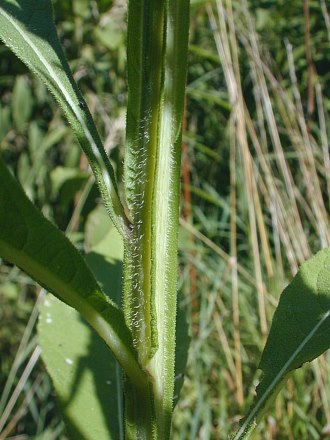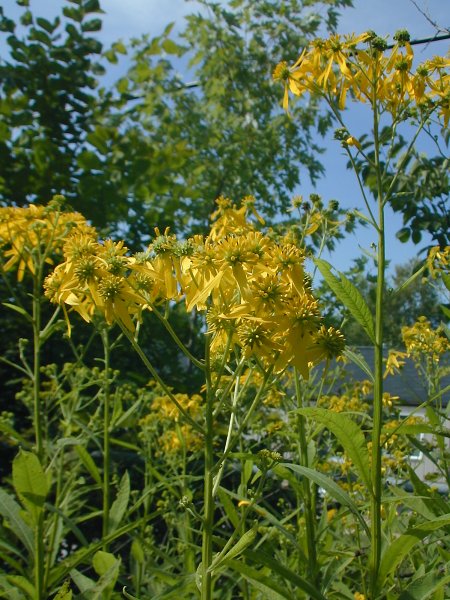Description: This perennial plant is 3-8' tall and unbranched. The central stem is erect and unbranched, except near the apex where the inflorescence occurs. It is usually winged, with long white hairs between the ridges. On rare occasions, the central stem lacks wings. The alternate leaves are up to 10" long and 2½" across; they taper gradually to petiole-like bases. The leaves are elliptic or lanceolate in shape; their margins are smooth, slightly serrated, or sparsely dentate. The upper surface of the leaves is medium green or olive-green and its texture is rough. The lower surface of the leaves is light green with white hairs along the major veins.

The upper stem
terminates in a dome-shaped panicle of flowerheads. These flowerheads
have a daisy-like structure and a
ragged appearance. Each flowerhead is about 1-2" across, consisting of
numerous disk florets that are surrounded by 2-10
yellow ray florets. The corollas of the disk florets are greenish
yellow and tubular in shape; they are conspicuous because of
their size, projecting outward from the center of each flowerhead
like a pincushion with thick needles. The petaloid rays are yellow and
oblong in shape; they usually extend downward and outward. The blooming
period occurs from
late summer to early fall, lasting about 1-1½ months. Sometimes the
flowerheads have a mild fragrance. The achenes are oval-shaped,
flattened,
and winged; each one has two short slender awns at its apex. They are
distributed to some extent by the
wind. The root system produces long rhizomes, often causing the
formation of vegetative colonies.
Cultivation:
The preference is full sun to light shade and moist to mesic
conditions. Wingstem typically grows in fertile soil that is high in
organic matter. The lower leaves may fall off the plant during hot dry
weather. Foliar disease, such as powdery mildew, occasionally damage
the leaves, particularly when a plant is under stress.

Range & Habitat: The native Wingstem occurs occasionally in most counties of Illinois; it is a little less common in the southern and NW areas of the state (see Distribution Map). Habitats include moist prairies, moist meadows near rivers and woodlands, woodland openings, woodland borders, floodplain forests, areas adjacent to woodland paths, thickets, savannas, partially shaded seeps, partially shaded areas along rivers, pastures, abandoned fields, and roadside ditches. This plant usually doesn't wander far from woodland areas or bodies of water. The deciduous woodlands where this plant occurs often contain such moisture-loving trees as American Sycamore, American Elm, Hackberry, and Silver Maple. Wingstem competes well against other plants in both high quality and disturbed habitats.

Faunal
Associations:
The flowers are visited primarily by long-tongued bees, especially
bumblebees. Some short-tongued bees, butterflies, and skippers also
visit the flowers; the long tubes of the disk florets make the nectar
inaccessible to many insects with shorter tongues, such as flies and
wasps. Several kinds of insects feed destructively on Wingstem and
other Verbesina spp.
Caterpillars of the butterfly Chlosyne nycteis
(Silvery Checkerspot) feed on the foliage, while caterpillars
of Basilodes pepita
(Gold Moth) feed on the flowers and developing seeds The caterpillars
of two Gracillariid moths, Cremastobombycia
ignota and Cremastobombycia
ambrosiaeella, are leaf-miners. Other insects that feed on
Wingstem include the leaf beetle Brachypnoea
clypealis, larvae of the gall flies Cecidomyia verbesinae
and Neolasioptera
verbesinae, the aphid Uroleucon
rurale, and Acrosternum
hilaris (Green Stink Bug). Because of the bitterness of
its
leaves, Wingstem isn't consumed by deer, rabbits, and other herbivores
to the same extent as many other plants. Animals may distribute the
awned seeds to some extent.
Photographic Location:
The photographs were taken at Judge Webber Park in Urbana, Illinois.

Comments: Sometimes this plant is called 'Yellow Ironweed' because of its fancied resemblance to Ironweed (Vernonia spp.). Both kinds of plants bloom at about the same time of year, share a similar height, have similar leaves, and like moist conditions. Their composite flowers, however, are dramatically different from each other in appearance. Also, Wingstem usually has a winged central stem, while Ironweed doesn't. The other species in this genus that can be found in Illinois, Verbesina helianthoides (Yellow Crownbeard), is usually found in moist to mesic prairies. This latter species is a shorter, hairier plant that blooms earlier in the summer; the ray florets of its compound flowers droop less, or they are held horizontally. In the past, Wingstem was assigned to the Actinomeris genus.